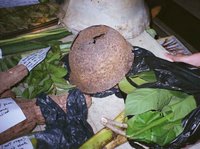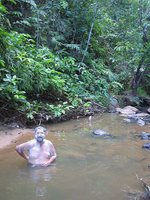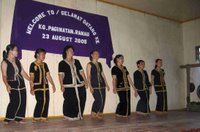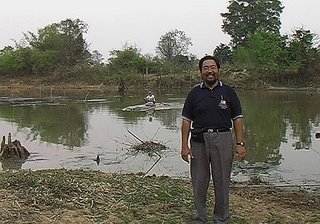IntroductionThe Death March held from 16-25 August 2005 is an event organised by the Sabah Society that commemorates the 60th anniversary of a sad episode in history when over 2,000 allied prisoners of war were forced on a journey by foot from Sandakan to Ranau under the most appalling conditions of starvation and cruel treatment. Our journey has been also called a peace walk by Tengku Adlin, a past president of the Sabah society who points out that an important reason for remembering the tragic events and atrocities of the past is for present and future generations to value peaceful co-existence between countries and within communities. Some participants had other reasons for walking but most of these were tied to the historical events that took place in Sabah (formerly known as British North Borneo) during the final months of the 2nd World War. The route of our 10 day walk is as close to the original one as possible and had been decided upon after detailed research and arduous reconnaissance by some intrepid members of the Sabah society. There are not many clear markings of the original route that crept through steamy mosquito infested swamps and thick thorny jungle that have since been replaced by private holdings and oil palm plantations.
HistoryToward the end of the war, the Japanese invaders knew that Allied forces were likely to recapture Borneo and free the 2,434 mostly Australian and British prisoners transferred from Singapore after the fall of Malaya and held in a prison camp about 8 miles North of the port of Sandakan. In days preceding our walk, I heard different accounts and interpretations from participants, journalists and interested parties of what happened and why; but what remains clear is that between January and June 1945 Japanese guards forced prisoners out of the prison camp in three separate batches to embark on a terrible journey in spite of their poor physical state. There was very little food and many prisoners had to walk barefoot over the rough terrain. Some of the stronger prisoners from the first two batches were forced to carry heavy loads of rice like pack animals whilst prisoners in the third batch were so sick or injured that all were killed during the early stages of the forced march before even reaching Beluran. Even though over 700 prisoners eventually completed the forced march, it appears that their captors had no intention of allowing any of them to survive the war and what eventually ensued can only be viewed as a prolonged merciless massacre through starvation, brutal beatings, torture and outright murder by blade or bullet from which only 6 prisoners survived, having escaped during the journey.
Just before the walkA memorial service and ceremony was held early in the morning on August 15 attended by local and f

oreign civilian guests as well as representatives from the Australian and Malaysian defence forces. The ceremony ended with a sad trumpet reveille and was followed by an exhibition on the history of the 1945 Death march in the Sandakan community centre. There was a briefing for all participants in the Sandakan yacht club that night followed by a forgettable dinner. Early the next morning, a total of 34 participants from Malaysia, Australia, the UK, Canada and the US and our ever present military escort started walking at 5:30 am from the war memorial (close to where the infamous prison camp once stood) along with other guests and dignitaries present at the simple starting ceremony who followed us for the first mile or so. Lynette Silver pointed out at the starting point that the day’s walk would bypass part of the original route over the Tindok and Samawang rivers where 60 bodies of prisoners had been recovered after the war. I believe this was because of logistical reasons (our camp for the first night would be in Ulu Dusun and the day’s walk had to be kept to within 40 km) as well as issues related to permission for walking through private land.
Our Journey beginsThe first day proved to be an enormous challenge with intense and unrelenting heat, exhaustion, longer-than-anticipated distance and blistered feet. On subsequent days new blisters would appear even before old ones had healed and there would be agony from tendons and muscles unaccustomed to so much walking. Yet, every walker soldiered on in spite of these problems remembering the courage of the prisoners before us who surely endured much more pain in their malnourished and tormented state; our pain and hardship must pale in comparison to theirs. In 1945, the remaining men in the third batch that were forced to march in June had been in such poor physical condition that none survived the early stages of the journey. Varying levels of fitness and youth among the participants saw a very wide gap of several km develop between the fastest and the slowest walkers and one or two even sought a little unsanctioned assistance from an unidentified object with rubber tyres and were not a little ashamed to admit it! There was such relief after walking over 39 km when we reached the community hall of the Ulu Dusun agricultural research station that afternoon to a resting place and cold beers found within it’s wall-less premises.
The second day saw us starting off at 4:00 am to avoid as much of the intense heat from the sun as possible and we passed through an area drained by the Dusun, Manjang and Kolapis rivers where the bodies of 44 prisoners were recovered after the war. The first part of the walk was on stony unsealed roads winding through mature oil palm plantations belonging to the Lai Fook Kim Group before joining a highway heading North toward the Forestry complex near Beluran. The distance of 26 km for the day was considerably easier than the previous day and most participants got in well before midday. The accommodation for the night was very comfortable thanks to the hospitality of the Forestry department and we were all invited to a video presentation in a wonderfully cool air conditioned room that afternoon. That afternoon most participants jumped onto a military truck for a short ride to the rustic little fishing port Beluran on the Labuk bay. Some of them had been there earlier for a sumptuous seafood lunch.
The

relatively short 10 km covered on the third day was the shortest of the entire journey and took only a few hours even for the slowest among us to walk from the Beluran Forestry office to Kampung Muanad, a village near the Tangkual crossing. Two participants from Sandakan missed walking this short stretch having travelled back to the comforts of home the previous day to get fresh shoes, etc. This calm peaceful site on the Muanad river belies it’s tragic past and is where 89 bodies of prisoners were recovered after the war. Eyewitness accounts indicate that several prisoners were swept away by the strong current of the river near a grove of wild fig trees, their bodies never to be recovered. In the local dialect, Tangkual is the word used for the wild figs. The local villagers were very hospitable and hosted a delicious dinner of local fare for us that evening, providing us with a good opportunity to mingle and chat with them. Some village children hung around the Australian army boys who generously doled out some of their rations and chemical light sticks. That night we met up with Haji Kangkawang, son of Encik Kulang, a decorated resistance fighter who helped one of the prisoners to escape in spite of the deadly risks involved. Haji was a young lad in 1945 and able to recount some of his memories then and agreed to an interview that had Geoff (Baby) Lemon busy taking down notes for his research project. Accommodation for the night was in a rickety wooden building on stilts that served as a community hall but some walkers chose to sleep outside or in an adjacent building.
The fourth day saw us covering a blistering 36 km from Muanad past Kampung Mandoring, the Sapi

river and oil palm plantations to Ulu Sapi, an area where 6 bodies were recovered after the war. Along the way I met Patma, a former colleague who manages one of the IOI estates along the way. We later stopped in a small holding (or farm) for lunch in the shade of young oil palms. For many of us, this long hard walk ended at the local community hall in the intense heat of the afternoon during which a walker collapsed and had to be put on a drip because of dehydration and exhaustion; he was subsequently sent to Kota Kinabalu by road that evening together with another person with an eye infection. The officer in charge of the Malaysian army escort arranged a vehicle to ferry us 42 km to a waterfall but not many wanted to go because most were worn out by the heat and wanted to lie down in the hot and not very clean hall. We eventually got to the river but not the waterfall because of the precarious off road conditions and had a wonderful bath in the cool and clear water of the gently flowing Meliau river.
We started early at just after 4:00 am on the fifth day for another long 35 km walk past Sapa Pyau and Kampung Batas (where 17 bodies of prisoners had been recovered after the war) to our camp for the night in a small Seventh Day Adventist church at Kampung Liningkung, not far from the sites of Bauto and Kampung Tauniting where another 12 bodies were recovered. Shortly after arriving at the church, some of us jumped onto an army truck for a ride to the lovely

Meliau river near Telupid for another bath. Those who did not join us had to bathe in a little stream flowing through Liningkung which is a tiny welcoming village where most people are poor but friendly. There is no electricity or treated water supply here. The villagers put up a small exhibition of old artefacts (like soldiers’ helmets, etc.) collected from after the war as well as roots and plants that the prisoners would have survived on during those dark days. That evening a collection was taken from among the walkers for the village community, this amounting to over RM300.
The sixth day of the journey was a relatively easy 17 km walk to the small town of Telupid on a Sunday morning passing by the Tapang river and Kampung Gambaron where the bodies of 5 prisoners were recovered after the war. After loitering around the Sunday market in Telupid while waiting to check into the accommodation in the forestry department complex, I met old friends Sally & Varghese who once lived on Gomali estate more than a thousand miles away where I had also served in a previous life. It was pleasant chatting with them on this unexpected encounter in the most unlikely of locations. Accommodation for the night was pleasant enough with cushions on a clean wooden floor and several more savvy walkers even had proper beds and air-conditioning! We had most of the day to ourselves, some wandering around town or shopping a little as they wished.
Early at 4 am on the seventh day, we started off for the villages of Mengkadait and Minruru where the bodies of 12 prisoners were recovered after the war. The walk had entered its mountainous phase and the scenery was beautiful over several stretches of the 32 km walk. On the way some walkers bought durians from the small farms along the way while others simply helped themselves without permission (they thought no one was looking) to tarap (Artocarpus spp.) fruit that they said would eventually rot away on the trees. The owners of the fruit trees were gracious enough to let that pass when we were actually discovered and even brought out a long pole for Vicky and her partners in crime to help themselves to even more rambutans and tarap

fruit. Such wonderfully hospitable local people! Just before Mengkadait we had to cross a beautiful stream with cold inviting clear water and Geoff (Baby) Lemon just had to get in. The little fish in the stream had a great meal nibbling off parts of Geoff’s dead skin from wounds and blisters and he didn’t mind at all. Meeting a group of children in Mengkadait was a bit of a shock seeing the devastating poverty; although they appear happy and adequately fed, many were dressed in rags, barefoot and appeared undersized. When we met the village head, he appeared to be in a state of intoxication – highlighting a common problem of substance abuse often seen where there is grinding poverty in rural areas. Camp for the night was at the Minruru village school at the foot of Gunung Mentapok. All of us had a nice bath in a nearby stream.
Early at 4:30 am on the eighth morning, we started walking uphill on a dirt road toward the highway and passed Kampung Tapias close to where the bodies of 5 prisoners were recovered after the war. We then joined the highway that crossed and ran parallel to the Liwagu river for part of our 36 km walk to Kampung Paginatan, a village that had been used as an ammunition dump, rice storage depot and p.o.w. camp (just behind the present government health clinic). As a result of horrific atrocities the bodies of 95 prisoners were recovered here after the war. It was here that a large group of Sabah Society members and friends joined us for the last 2 days of our walk to Ranau. Lynette and her husband performed an aboriginal cleansing rite burning

eucalyptus leaves whilst Junko burnt incense remembering that hundreds of Japanese soldiers and guards who also died during this sad episode because of the harsh conditions. The villagers were very hospitable and had even constructed a set of new bathrooms and toilets beside the community hall (our camp for the night) when they were told we were coming. They even cooked up the evening meal and staged a cultural show for us that night followed by generous servings of the traditional local brew.
A larger group that included the newcomers arose at 3:30 on the ninth morning; one or two unused to the early schedule complained when the lights were switched on. Nevertheless most walkers started off by around 4:00 am for the 32 km walk to Kampung Muruk past the villages of Nalapak and Seginda where the bodies of a total of 9 prisoners were recovered after the war. The villagers were waiting for us as we walked past and feted us with a warm welcome in traditional costume and the beating of gongs and gave us local fruit from their orchards. One of the walkers who had pushed herself too hard during the day collapsed in front of us and had to be put on a saline drip and later transported to the nearest town. That evening, after settling down in an old school house inside the compound of a native church, we were treated to a cultural performance put up by the villagers and their children.
The Journey endsOn August 25, 2005, the final morning of the re-enactment of the 1945 Death March, starting after sunrise, we walked 13 km over a steep hill separating Muruk village from our final destination in the town of Ranau, over a route the original prisoners would have been likely to have used to the prison camp where the remains of 395 prisoners were recovered after the war. It was a cr

isp beautiful morning made exciting but yet sad by the fact that the long walk was finally coming to an end. The poignant event ended at the war memorial in the compound of a SIB church that had been the site of a p.o.w. camp with a brief ceremony held near to where so much pain, suffering and death had occurred 60 years ago.
Whilst a few of us had to rush off immediately after the closing ceremony, the rest of the participants were hosted to a sumptuous barbeque dinner at the Pine resort in Kundasang that evening and even went on celebrating well after that – so we are told. It had been for most of us that walked the entire 290 or so kilometres a wonderful experience that nearly all said they would never repeat again – possibly because of the amount of time it had taken, the ruptured blisters, mercilessly searing sun or painful bouts of tendonitis that were still fresh in their memories. I do however believe that for each one of us it had been a journey we would not easily forget even if we had very different reasons for being there and the feelings of friendship would last long after the fond farewells.
In a media article, the president of the Sabah Society, Dr. AC Heng spoke of the genuine friendship and hospitality of the people in Sabah as being perhaps the most important aspect of the entire march, most of us having felt the warmth of the people with very little but yet willing to share all they had. Through them Sabah stood up and proudly exhibited its reputation for friendship, hospitality and natural beauty and the Society has succeeded in highlighting these qualities. Strong bonds of friendship have also been forged among ourselves and friends from abroad. It is hoped that these will promote peace and harmony among nations so future memories will be happier than the ones built on war.
Many thanks to Pam & Dr. Dave Sidhu, Dr. Ravi Mandalam, Dr. Tim Chang and Rina & Bill Jamieson for generously sharing so many lovely photographs, some of which appear above.









 On Christmas morning we went to Coastal church for a beautiful Christmas service.
On Christmas morning we went to Coastal church for a beautiful Christmas service. The BCC commenced in early January 2008 under the able leadership of Steggy and Andy Thomas. The first few weeks when we acquired vital charting skills during the seminar phase of the course were particularly demanding. This initial intensity in a way makes it seem more demanding than the 9 month SBS which covers the whole Bible.
The BCC commenced in early January 2008 under the able leadership of Steggy and Andy Thomas. The first few weeks when we acquired vital charting skills during the seminar phase of the course were particularly demanding. This initial intensity in a way makes it seem more demanding than the 9 month SBS which covers the whole Bible.



























